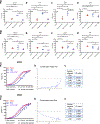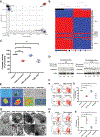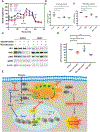Novel Targeting of Transcription and Metabolism in Glioblastoma
- PMID: 29254993
- PMCID: PMC8108069
- DOI: 10.1158/1078-0432.CCR-17-2032
Novel Targeting of Transcription and Metabolism in Glioblastoma
Abstract
Purpose: Glioblastoma (GBM) is highly resistant to treatment, largely due to disease heterogeneity and resistance mechanisms. We sought to investigate a promising drug that can inhibit multiple aspects of cancer cell survival mechanisms and become an effective therapeutic for GBM patients.Experimental Design: To investigate TG02, an agent with known penetration of the blood-brain barrier, we examined the effects as single agent and in combination with temozolomide, a commonly used chemotherapy in GBM. We used human GBM cells and a syngeneic mouse orthotopic GBM model, evaluating survival and the pharmacodynamics of TG02. Mechanistic studies included TG02-induced transcriptional regulation, apoptosis, and RNA sequencing in treated GBM cells as well as the investigation of mitochondrial and glycolytic function assays.Results: We demonstrated that TG02 inhibited cell proliferation, induced cell death, and synergized with temozolomide in GBM cells with different genetic background but not in astrocytes. TG02-induced cytotoxicity was blocked by the overexpression of phosphorylated CDK9, suggesting a CDK9-dependent cell killing. TG02 suppressed transcriptional progression of antiapoptotic proteins and induced apoptosis in GBM cells. We further demonstrated that TG02 caused mitochondrial dysfunction and glycolytic suppression and ultimately ATP depletion in GBM. A prolonged survival was observed in GBM mice receiving combined treatment of TG02 and temozolomide. The TG02-induced decrease of CDK9 phosphorylation was confirmed in the brain tumor tissue.Conclusions: TG02 inhibits multiple survival mechanisms and synergistically decreases energy production with temozolomide, representing a promising therapeutic strategy in GBM, currently under investigation in an ongoing clinical trial. Clin Cancer Res; 24(5); 1124-37. ©2017 AACR.
©2017 American Association for Cancer Research.
Conflict of interest statement
Disclosure of Potential Conflicts of Interest
T. Estok holds ownership interest (including patents) in Tragara Pharmaceuticals, Inc. No potential conflicts of interest were disclosed by the other authors.
Figures






References
-
- Stupp R, Mason WP, van den Bent MJ, Weller M, Fisher B, Taphoorn MJ, et al. Radiotherapy plus concomitant and adjuvant temozolomide for glioblastoma. N Engl J Med 2005;352:987–96. - PubMed
-
- Malumbres M, Barbacid M. Cell cycle, CDKs and cancer: a changing paradigm. Nat Rev Cancer 2009;9:153–66. - PubMed
Publication types
MeSH terms
Substances
Grants and funding
LinkOut - more resources
Full Text Sources
Other Literature Sources
Medical
Molecular Biology Databases
Research Materials
Miscellaneous

